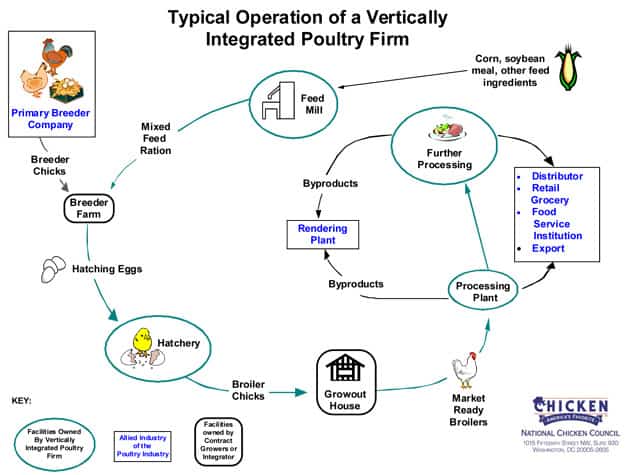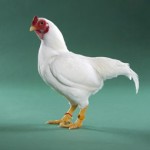How domestication altered the Chicken (and human culture!): industrial agriculture
Having requirements for uniformity in our personal lives transfer to the want for uniformity in basic life of the chicken (genotype, breed, feed, production process) (Barbato, 1999 p. 32). Galusky suggests that we have not only made uniform the chicken body, but too the interactions of humans who still produce, haul, and process chickens (Galusky, 2010, p. 24).
One cannot fully consider the historical evolutionary development of chickens and humans together without discussing today’s industrial agriculture…..
Today we value technical, scientific, and rational approaches to face and solve many of life’s uncertainties. Before industrial agriculture, generations trusted ‘augury’, or knowledge gained about the present and future though patient observation and intimacy with animals. Today, in accepting that the purpose of a chicken is for meat and eggs governed by economic market efficiency we are losing our ability to see what they augur for our collective future. In short, in the last 100 years, we have deskilled ourselves of the delicate ability to find animal behavior messages about our identities and our planet. The move from “farm chickens to chicken farming” has produced similarly a decline in cultural awareness.
In this post I discussed how the Red Junglefowl has changed little over thousands of years. It was human intervention, however, that produced the hundreds of breeds of chickens today. Winning birds of cock fights provided the breeding stock, so fighting cocks naturally became bigger over the centuries. Indian fighting cocks were imported into England and were the basis for Old English bird stocks, also used for fighting. They, in turn, provided the basic genetic material for the Cornish breed, a chicken with extreme muscling that resulted in a broad breast.
We’re producing the “chicken of tomorrow” (complexities of culture, government encouraged chicken farming and made the prices higher. World War two propaganda highlighted the importance and value of keeping chickens and the effect on the poultry industry was significant, “broiler production increased almost threefold; the vertical integration of industry combined feed processing, hatcheries, grow-out facilities, and poultry processors into one company with new economies of scale for the streamlining and rationalization of poultry production. (Squier, 2011, pp. 20 – 44)”

In 1980 there was anticipation for economics that would come to govern poultry breeding and production. One can increase the value of a chicken by incorporating desired traits, but this is risky, in doing this modification it could cause other valued traits to disappear. It is hypothesized that selected genetic alterations of chicken domestication for increased production are the causes of decreasing reproductive fitness. Indeed, the poultry production industry has been experiencing problems of disease resistance, juvenile mortality, maladaptation to stress, and the ability of the broiler breeder male to fertilize eggs is suggested to be declining at a rate of 0.5% a generation (Barbato, 1999, p. 445).
Barbato explains (1999) , “The domestic and international poultry industries have gone through many changes over the last 50 years. The industry has matured from a “backyard flock” mentality, supplying Sunday chicken dinner, to sophisticated mass production of poultry meat and eggs (p. 444).”

Confinement of birds in high-density populations makes them more susceptible to disease, a problem we have addressed by dosing industrial flocks with antibiotics. These are often the same or similar antibiotics used by humans, and widespread use for poultry production has led to development of bacterial resistance to antibiotics. Now these resistant strains of bacteria are making humans sick and treatment difficult. Industrial poultry farming involving millions of chickens produced per farm has also resulted in high nitrogen runoff into rivers and streams, contaminating water supplies and contributing to other environmental problems (V. Evans, Fowls and Pheasants (Phasianidae), 2004).

It takes less than two pounds of feed to produce one pound of chicken (live weight), less than half the feed/weight ratio it took in 1945. Gary Balducci, a third-generation poultry farmer in Edgecomb, Maine, can turn a day-old chick into a five pound broiler in six weeks, half the time it took his grandfather. And selective breeding has made the broilers so docile that even if chickens are given access to outdoor space—a marketing device that qualifies the resulting meat to be sold as “free-range”—they prefer hanging out at the mechanized trough, awaiting the next delivery of feed. “Chickens used to be great browsers,” say s Balducci, “but ours can’t do that. All they want to do now is eat.”
It is hard to remember that these eating, clucking, metabolizing and defecating hordes awaiting their turn in the fryer are the same animals worshiped in m any parts of the ancient world for their fighting prowess and believed by to be in direct communication with Fate. A chicken bred for the demands of shoppers presumably has lost whatever magical powers the breed once possessed. Western aid workers discovered this in Mali during a failed attempt to replace the scrawny native birds with imported Rhode Island Reds. According to tradition, the villagers divine the future by cutting the throat of a hen and then waiting to see in which direction the dying bird falls—left or right indicates a favorable response to the diviner’s question; straight forward means “no.” But the Rhode Island Red, weighted down by its disproportionately large breast, always fell straight forward, signifying nothing meaningful except dinner (Lawler & Adler, June 2012).

Evolution, History, and Domestication of Chicken | Gameness til the End
22 September, 2013 @ 2:46 am
[…] of the chicken meat industry shows how chickens have moved from one continent to another and how humans have changed the function of the chicken in the process (Latshaw & […]